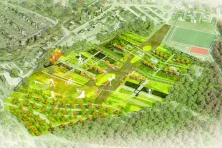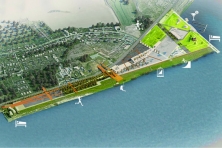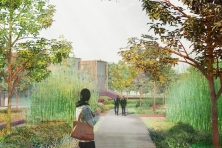Urbanochory
Bitterfeld-Wolfen (DE) – Mentionné
DONNÉES DE L'ÉQUIPE
Représentant d'équipe : Thomas Giuria (FR) – architecte ; Associés : Emilie Horz (FR) – architecte
16 Mail Renaissance, 95120 Ermont – France
+33 6 70 02 04 28 – thomas.giuria@outlook.com
Voir la liste complète des portraits ici
Voir la page du site ici

Th. Giuria et E. Horz
INTERVIEW (en anglais)
1. How did you form the team for the competition?
Taking part in a competition is a project as old as our friendship. Since school, we have worked our separate ways in the complementary fields of architecture and urbanism. Europan 12 was the perfect opportunity to join our experiences, to test our teamwork and maybe to deal with day-to-day work frustrations. It was obviously harder than expected, but a very valuable experience.
2. How do you define the main issue of your project, insisting on how you answered on this session main topic: adaptability and urban rhythms?
In a sustainable process of urban renewal, of rebuilding the city over the city; unused, abandoned lands and in-betweens appear as strong potentials.
Both project sites are singular by their localization, programs, assets and constraints. Therefore, the main problematic was to inscribe them in a global dynamic –at the city scale– rather than creating isolated operations. We wanted them to carry a common and unique identity.
Our urban project relies on both public and green spaces networks, as links, in order to develop two news polarities based on the reactivation of neglected and abandoned spaces and the invention of new practices.
Designed like a living organism, neither frozen nor immutable, the project is the reflect of a collective work throughout time, based on existing premises, in a context of urban recycling.
The adaptability in terms of spaces and time mutability is enabled by the possible densification of the housing area, and the phasing of the tourist area. But adaptability is also at the core of the public and green spaces, allowing flexibility of uses and temporalities.
Unity and readability of programs offer various rhythms to the city. They also enable to optimize singularity of suggested sequences and to set them in a multi-scale reality. Each element adds value to the urban framework, the touristic offer or the ecological system.



3. How did this issue and the questions raised by the site mutation meet?
The parameter of mutability must be integrated early in the project to allow a large flexibility in the evolution and the needs of the constantly changing neighbourhood.
Mutability of both sites is a matter of real identity above all. Starting with virgin territories, which are off centered from the historical urban frame, we first tried to inscribe our intervention in the continuity of the Expo 2000, highlighting the natural and landscape assets of both sites. We then aimed at adapting the program to the theme in order to define consistent goals, taking into account the new identity and the sought living quality.
In order to offer an adaptable space, through permeability of blocks and programs shifting, we imagined a project that is able to mutate in time. For instance, the inhabited park, where public and green spaces are integrated in the collective plots of land, materializes the search of mutability.
4. Have you already treated this issue previously and could you present some reference projects that inspired yours?
Emilie has worked on the adaptability of urban rhythms during her final exams, working on the reconversion of the Francfort-am-Main industrial area.
Phasing is a common subject when working on urban planning. However, Europan 12 provided us with the opportunity to broaden the vision beyond the district scale and to expand the reflection to economical, environmental or educational considerations, giving us the opportunity to create a consistent and viable proposition.
5. Today –within the era of an economic crisis and sustainability– the urban-architectural project should reconsider its production method in time; how did you integrate this issue in your project?
The financial aspect has been included, however, instead of cutting on the quality of the proposed spaces, we rather rested upon a phasing that is very adaptable to financial incomes.
The urban project is based on urban markers and driving projects in every area. Land plots that are left unbuilt during first phases are valued by their integration in the green framework, in order to minimize maintenance costs, while maximizing their impact in the global project (biodiversity, phytoremediation and educative values).
6. Is it the first time you have been awarded a prize at Europan? How could this help you in your professional career?
This competition is a first for us, making our runner-up award a very encouraging and inspiring one. We would like to thank the jury for their very insightful and positive comments on our work. This might be the first stone of a new adventure! As for now, we are very thankful to the Europan team.